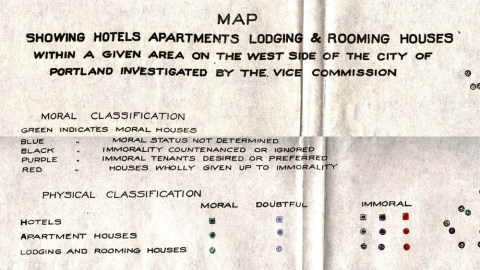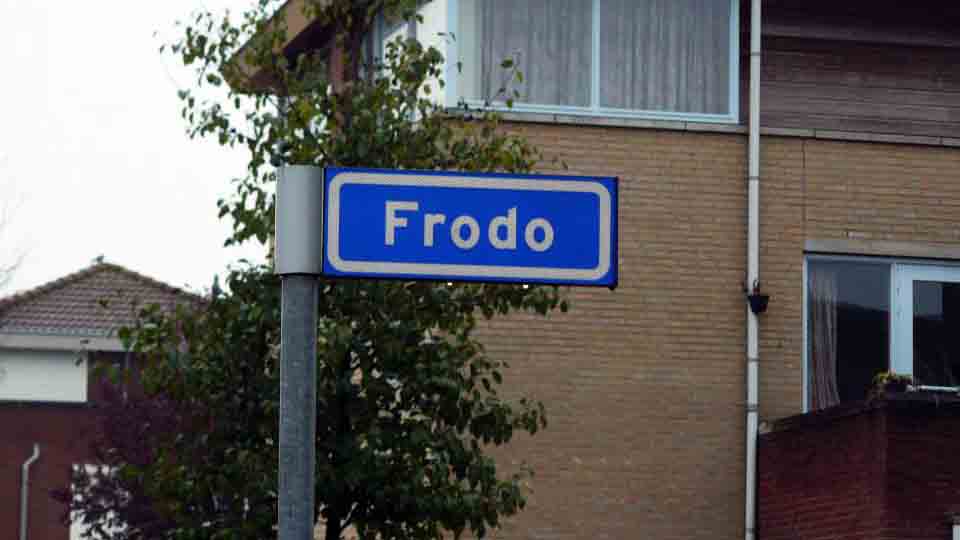A Moral Topography of Portland, Oregon

According to Portlandia, Portland, Oregon, is a city best known for its wannabe hipsters, oddball mayor — and a cottage industry devoted to pickling just about anything.
This map tells a different story, and isolates a single element from the topography of Portland: the moral standing of the city’s rentable rooms in the year 1913.
By various symbols and a five-color code, the city’s hotels, apartments and rooming houses are rated either moral, immoral or ‘undetermined’. The immoral category, vastly outnumbering the other two, is subdivided into accommodation where immorality is ‘countenanced or ignored’, places where immoral tenants are ‘desired or preferred’, and houses ‘wholly given up to immorality’.
This vast archipelago of turpitude floats on an otherwise completely blank map, as unmoored from its physical surroundings as it is from its historical context. The resulting image is of Portland, a century and a year ago, as a monoculture of promiscuity, an entire city dedicated to the spread of (varying degrees of) immorality.
That is perhaps too shocking an effect even for the concerned citizens on the board of the Portland Vice Commission, who in 1913 produced a Report on the “Social Evil”, as affecting places of public resort and accommodation.
The aforementioned, capitalised Evil in Victorian times was the generally understood euphemism for prostitution – a scourge not peculiar to Portland, the Commission points out: Similar investigations in large cities reveal a like state of affairs. The disgrace and humiliation lies in the existence of these conditions and not in the statement of them.
Hence the report and the accompanying map – but, in both cases, anonymised, for [i]t is the function and policy of this Commission to deal with conditions and not persons. For this reason and because this body is in no sense a detective bureau for the purposes of prosecution, the data set forth in this report avoids, as far as may be, identification of places and individuals.
In the Foreword, a grim summation: Facts stated in this report will make it clear that conditions are bad […]Total number of places investigated: 547. Moral: 98. Doubtful: 18. Immoral: 431. Further in the report, the immoral places are specified as: Wholly given up to prostitution or assignation: 113; Immoral tenants desired or preferred: 124; and Immorality countenanced or ignored: 194.
Mind you, these figures don’t even relate to what the report calls bawdy or “parlor houses” (i.e. outright brothels), but merely to those places of public resort and accommodation […] which by advertisement solicit the patronage of the public: hotels, apartment houses, rooming and lodging houses.
The report found, specified per type of dwelling, only 22 of 80 apartments, merely 5 out of 59 hotels and no more than 71 out of 408 rooming and lodging houses to be ‘moral’. It urged that the ‘commercialization of vice’ in these places be dealt with, among other reasons, because of the constant and insidious danger of contamination to the unsuspecting and unsophisticated.
Throughout its pages, the report related the findings of its ‘inspectors’, who had posed as prospective clients at Portland’s various hotels and rentable rooms. These ‘morality reviews’ are fascinating windows into early-20th-century Portland.
Some excerpts from reports on hotels of the ‘immorality countenanced or ignored’ category:
* Hotel –, – Stark Street. An attractive looking new hotel just off the upper business district. Several sporting girls (sic) live here, one notorious in the under world. Two moved in recently from one of the most notorious dives in the city. Management states that there are too many hotels in Portland for proprietors to lay down laws governing guests and their habits.
* – Hotel. On the water front, run by a Japanese. Rooms rented several times a day. Outwardly respectable, but immorality is permitted if done in a quiet way. Raided since report.
Some excerpts from reports on hotels in the ‘immorality desired or preferred’ category:
* Hotel –, – Ash Street. A disreputable place, attractive in appearance, which houses both professional sporting women and occasional prostitutes, some of whom pay bed money to the landlady, who owns another hotel of a similar character. Twenty-five rooms reserved for this class of trade.
* – Hotel, – Columbia Street. Large transient trade. Girls who sport here known as $2 women. Sell liquor in their rooms, $1 a bottle for beer, 25 cents a drink for whisky. Chambermaids employed here also used for sporting purposes. Rooms rented several times a day. Landlady conducted this class of business under guise of respectability.
Some excerpts from reports on hotels in the ‘wholly given up’ category:
* Hotel –, – Taylor Street. Shabby place of 46 rooms. Run by man and woman, who occupy front rooms, one of which the woman uses as a parlor, the other as a bed room for immoral business. Three prostitutes work for management, paying one-half of their earnings from bed money. Liquor sold.
* – Hotel, – Seventeenth Street. Several sporting women live here. Proprietor recently bought place with avowed intention of increasing this class of trade if he could get the “right kind of girls”. Business is carried on quietly.
Some excerpts from reports on lodging and rooming houses in the ‘immorality countenanced or ignored’ category:
* The –, – Yamhill Street. Landlady an attractive looking woman. Six sporting women here. Large transient trade of men. One of the chambermaids sports at night outside of the house. Management pays no attention to the conduct of the guests.
* The –, – Jefferson Street. Twenty-nine rooms. Promiscuous privileges permitted. Landlady stated there were no regulations governing guests. It was all she could do to look after “my house without looking into the affairs of roomers”.
Some excerpts from reports on lodging and rooming houses in the ‘immorality desired or preferred’ category:
* The –, – Washington Street. New place of 60 rooms in suites or single. A number of women live here. Proprietor says “there is no objection to you as a sporting woman coming here to live. Of course if people make too much noise or get into the hall we can’t afford that, but quiet women are never disturbed here as long as they pay their rent; in fact, we consider them preferable”. This place is of respectable appearance.
* The –, – Burnside Street. An ill-kept lodging house of 82 rooms, run by two Greeks. Patronized by a disorderly class. Five prostitutes in place, who charge 50 cents a bottle for beer. This place patronized largely by foreigners.
Some excerpts from reports on lodging and rooming houses in the ‘wholly given up’ category:
* – rooming house, – First Street. Shabby, disorderly place of 26 rooms, owned by – brewery. Saloon underneath. Landlady formerly keeper of a bawdy house. Three uncleanly, dissipated sporting women here.
* The –, – Washington Street. A new place recently opened, attractive in appearance. Runs cautiously. Among others there are two “French” women doing business. Proprietor says: “We are here for money and we propose to make it. The question of how we make it is not so important just so we make it”.
Perhaps another reason why both the report and the accompanying map were anonymized was to prevent either from serving as a ‘tourist guide’ to Portland’s more promiscuous ports of call. Paid visits to ‘sporting girls’ must have been extremely popular at the time. Judging from the number of places surveyed and the size of the population at the time – about 220,000 – there was about one ‘immoral location’ for every 500 inhabitants.
Even anonymized, the report revealed that a considerable amount of buildings in which these ‘immoral’ activities were occurring, were owned by ‘respectable’ citizens of Portland. One effect of the report therefore was the so-called Tinplate Law, providing that the names of both the owner and the agent of any building housing multiple residences be posted in the hallway.
This map was found here on Vintage Portland, which went to the trouble of overlaying the blind vice map on a present-day map of Portland. Come to think of it – the current map in its way is also blind… to today’s vice. So here is a weird combo: 20th-century vice on a 21st-century grid.
In the comments section of the article, some indication as to the actual location of some of these dens of immorality is offered:
“One of the surprises for me was the cluster west of the present 405, north of Burnside (today’s ‘Alphabet District’). A couple decades prior that would have been uncomfortably close to some of Portland’s wealthiest- this hints that their exodus to the hills was well under way”.
“I have read in old Oregonian articles that the center of Portland vice in the 1870s was 3rd and Tayor, the so called ‘Corridor of Death’ and that it was pressured to move to the old North End”.
To read the Vice Commission’s entire 1913 Report, go here at the Harvard University Library.
Strange Maps #677
Got a strange map? Let me know at strangemaps@gmail.com.









